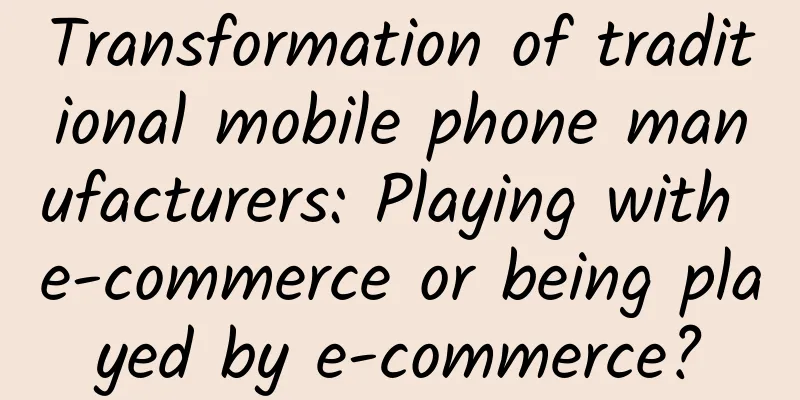Transformation of traditional mobile phone manufacturers: Playing with e-commerce or being played by e-commerce?

|
Recently, the industry earthquake caused by the news that the State-owned Assets Supervision and Administration Commission notified the three major operators to significantly reduce marketing expenses has affected all mobile phone hardware manufacturers. After Yu Dazui publicly announced that the sales ratio of operator channels would be reduced to about 20%, there was news recently that the cooperation between Samsung and China Unicom broke down, and Samsung mobile phones may be withdrawn from China Unicom's phone subsidy list. At the same time, China Mobile also reported that the phone subsidy for cooperative brand products that do not meet the 5-mode 18-frequency standard will be reduced to no more than 30%, and all operators have cancelled the strategy of giving away mobile phones for depositing phone bills and switched to a strategy of giving away phone bills for purchase... All signs indicate that in China, the tradition of "holding the thighs of operators to enjoy a good life" for many years will be broken. How will the former top four "China Cool Union" face various challenges under the new situation? Will it be a chic turn or a tragic fall behind? This is a big problem. History: The rise of the operator subsidy model created the China Cool Alliance "Deposit phone bills and get a free phone, free phone" - as early as the end of the last century, European operators such as O2 and Vodafone, and Japanese operators such as DoCoMo, in order to quickly expand the 3G market, adopted this model to promote their products. At that time, many people who went abroad had the impression that "mobile phones abroad are free", but when they bought them back home, they found that they could not be used. It turned out that the reason why these terminals were cheap was because the operators subsidized them. For this reason, terminal companies must lock these terminals in the network of a certain operator, and they could not be used even if they changed to other operators' cards, and of course they could not be used when they returned to China. In 2003, China Unicom's CDMA network had just been built. Compared with the mature GSM, CDMA network was not superior in terms of network coverage, terminal variety and cost, so it began to subsidize terminals. Later, China Unicom launched the CDMA/GSM dual-mode mobile phone "World Wind" in the hope of attracting GSM customers to join CDMA. At this time, some visionary companies began to cooperate with operators. For example, Coolpad's first CDMA mobile phone, Coolpad 688, was priced at 4,980 yuan at the time. With the help of the operator's subsidy policy, it achieved good sales and made the first pot of gold, laying the foundation for the future ranking of the top four of "China Cool Union". When China Mobile obtained the TD-SCDMA 3G license, it faced the dilemma of immature technical standards and lack of terminal products. Especially for terminal and chip manufacturers, market sales were unpredictable. How could they easily make up their minds to invest huge resources in research and development and production? To this end, China Mobile began to implement terminal subsidies and adopted preferential policies in terms of business assessment and financial indicators, hoping to achieve the goal of "making determination within the company, giving customers confidence and reassuring partners." As a result, the number of 3G users of China Mobile increased by nearly 17 times from 5 million in 2009 to 20.7 million in 2010, 50 million in 2011, and finally to 87.86 million at the end of 2012, in just three years. This also created the glory of "China Cool Alliance". It can be said that these four companies are models of rising with the help of operators. Current situation: Traditional channels are declining and e-commerce is becoming more popular While we exaggerate the decisive role of operators in the development of the mobile phone industry, we cannot ignore the sales role played by traditional offline retail stores. For example, Gionee, BBK, OPPO and Lenovo also have very strong offline sales channels. However, our consensus is that with the intensification of industry competition, the price and gross profit of mainstream products have fallen, and the situation of traditional retail stores has been difficult and the number has been shrinking in the past two years. This has also been recognized by many mobile phone manufacturers. In order to survive, their business model has gradually evolved from simple product sales to integrating into operator business in order to obtain more sources of income. On the contrary, the e-commerce model in the current mobile phone industry is very popular, especially e-commerce manufacturers represented by Xiaomi, which has achieved an annual sales volume of 18.7 million units from zero in just three years, ranking among the top five in the industry. Seeing that this market is so hot, many traditional brand manufacturers with a long-term vision have begun to try the e-commerce operation model, such as Coolpad's Dasheng, Huawei's Honor, ZTE's Nubia, Tianyu's Nibiru, Gionee's IUNI, OPPO's OnePlus, etc., were born. In particular, it was recently revealed that operators cut marketing expenses, which directly affected the sales of various brands supported by operators. It is a consensus among many manufacturers to expect e-commerce to make up for this shortfall. Currently, the e-commerce channels are dominated by Xiaomi, Honor, and Dasheng, accounting for more than 70% of the total market share. Xiaomi's online and offline ratio is about 7:3, while Honor accounts for about 25% of Huawei's overall share. From the beginning of this year to now, Dasheng series has sold at least 6 million units, accounting for about 20% of Coolpad's overall sales. Together with several other e-commerce brands, from the data, the e-commerce model has gradually become a trend in the sales of the mobile phone industry. Future: E-commerce will become the mainstay and independent brands will become the trend E-commerce has become the mainstream channel for mobile phone sales mainly due to changes in two aspects: First, the development of mobile phones themselves has changed a lot. From feature phones to smart phones, it seems that mobile phones are more diverse and more numerous, but in fact, mobile phones are more standardized. Mobile phones are measured by a series of standardized coefficients such as memory, CPU, system, screen, battery, etc. The operability of consumers purchasing through the Internet has been unprecedentedly improved. Secondly, consumers' consumption of mobile phones has passed the primary stage. Most consumers can make rational purchases based on their actual personal needs. People's understanding of mobile phones has also greatly improved. The fear of online purchases no longer exists. Mobile phones can be purchased more conveniently and at a better price through Internet e-commerce. According to Sino Consulting data, China's e-commerce mobile phone sales increased from 7 million units in 2010 to 30 million units in 2012, and the proportion of e-commerce increased rapidly from 2% to 15%. At the same time, e-commerce platforms are also paying more attention to mobile phone categories. Take the five-year development of JD.com's mobile phone category as an example: the sales volume was 30 million yuan in 2007 when it went online, and it maintained an annual growth rate of nearly 400% in the next three years. In 2010, it achieved a sales scale of 1.5 billion; in 2011, it achieved a sales scale of more than 4 billion; and in 2012, JD.com's mobile phone category sales are expected to reach 10 billion. At present, JD.com's mobile phone category accounts for more than 70% of self-sales B2C, and is still growing. Why do so many traditional manufacturers want to create a new e-commerce brand? The simplest reason is to clearly separate the online and offline product lines, and even to strictly separate the appearance and configuration of the products. The advantage of e-commerce is that it eliminates a lot of expenses for physical stores and channels, saving costs, so it has a considerable advantage in terms of selling price. If it cannot be effectively separated from offline, it will cause chaos in the price system, which is a typical left-hand and right-hand competition, and the manufacturers themselves will suffer the consequences in the end. At present, the Honor series has been separated from Huawei's brand system and is specifically targeted at e-commerce channel sales. Its leader Liu Jiangfeng was once speculated by the outside world to take over Yu Dazui's job, but in fact he is independent. When Dashen released its new product F2 on August 26, it also announced its independence and established an independent business unit specifically for e-commerce channel sales. Although China Unicom has not taken any action, the launch of its Golden Eye e-commerce product is unlikely to guarantee the emergence of an independent e-commerce brand. In short, the independence of traditional manufacturers' e-commerce brands is an inevitable trend. Difficulty: E-commerce channels will also stage a fierce competition for resources Many traditional manufacturers believe that the Internet is unlimited, so the resources of the e-commerce model are also unlimited. This sounds correct on the surface, but the reality is that what you need are users, and the Internet is just a medium or a tool, so the resources of the e-commerce channel are also limited. In the past, the most well-known e-commerce platform was Taobao, but its uneven quality and poor reputation discouraged many people. Later, the rise of B2C platforms such as JD.com, Amazon, Yixun, and Yihaodian allowed e-commerce to truly enter a golden period, and the Tmall model was later established. At present, JD.com still has the best sales of 3C products, accounting for more than 70% of the total, but no matter how big the cake is, it cannot withstand so many e-commerce brands to share it, so finding another way has become a top priority for e-commerce companies. For example, when Coolpad NOTE was launched, it did not choose JD.com but was directly launched on QQ Space. In addition, the number of reservations for Redmi smartphone exceeded 5 million within 72 hours of its launch on QQ Space. These all show that as long as there is popularity, it can be a promotion platform for e-commerce. Take QQ Space as an example. Currently, there are 611 million monthly active users, 70% of whom access QQ Space through mobile phones. The core users are people aged 16-35, which is highly consistent with the main customer group of e-commerce products. In terms of conversion rate, Xiaomi, for example, sent 120,000 purchase codes to users through QQ authentication space in May, and the number of orders was 45,000, with a sales conversion rate of 37.5%. In addition, platforms like Douban, WeChat, Weibo, Kaixin, Renren, etc., as long as there are people gathering, are likely to be the platforms that e-commerce will focus on next, especially targeted product releases. For example, if you have petty bourgeois tastes, I go to Douban, and if you focus on karaoke, I go to Tianlai KTV. Therefore, e-commerce channel resources are not unlimited. Whoever occupies a position first will gain the upper hand. As a winner of Toutiao's Qingyun Plan and Baijiahao's Bai+ Plan, the 2019 Baidu Digital Author of the Year, the Baijiahao's Most Popular Author in the Technology Field, the 2019 Sogou Technology and Culture Author, and the 2021 Baijiahao Quarterly Influential Creator, he has won many awards, including the 2013 Sohu Best Industry Media Person, the 2015 China New Media Entrepreneurship Competition Beijing Third Place, the 2015 Guangmang Experience Award, the 2015 China New Media Entrepreneurship Competition Finals Third Place, and the 2018 Baidu Dynamic Annual Powerful Celebrity. |
<<: Can the transformation into a "living room computer" be a lifeline for OTT boxes?
>>: From love to hate: Why did Microsoft abandon Nokia and WP brands?
Recommend
Using macaca for mobile hybrid automation testing (Part 2)
Macaca macaca is an open-source automated testing...
He Xiaopeng's view on the new energy vehicle market: Xiaopeng will occupy one of the seven parts of the market? Not necessarily!
At the "10 Years of Passion Night" pres...
6 marketing strategies that work well on the Internet and in physical stores, with 18 real cases included!
Without further ado, let’s get straight to the po...
Everyone wants to make the next "The Debaters". Can it be done by moving the satellite TV's super variety show to the Internet?
There are more and more super variety shows movin...
8 ways to promote on Xiaohongshu, shared with you!
I spent 2 months testing, during which I found tw...
China Automobile Dealers Association: The automobile dealer inventory coefficient was 1.76 in October 2022
On November 10, 2022, the China Automobile Dealer...
The mobile phone "nuclear war" is not over yet
Once upon a time, when we bought mobile phones an...
What are the functions of Lanzhou Financial Mini Program? How much does it cost to make a financial app?
With the advent of the 5G era, the financial indu...
This smell is really "nan"! The heather flower, which is on the hot search list, is actually full of treasures
There is a popular saying: "If you can't...
Master the user portrait knowledge system from 0 to 1 in one article
I took a course on user portraits some time ago, ...
Who was the ancient human with the largest brain capacity in the Middle Pleistocene? The answer is revealed!
Human brain capacity is closely related to intell...
What is the content of online promotion work and what are the specific responsibilities of promotion work?
With the continuous development of the Internet, ...
Calculate rationally and order emotionally: Why are we so easily prone to impulsive consumption?
Cross-store discounts, instant discounts for depo...
Price inquiry for development of Yanbian Flower Mini Program. How much does it cost to develop Yanbian Flower Mini Program?
There is no doubt that the topic of mini programs...









